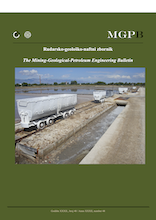Analysis and interpretation of regional-scaled gravity measurements in the Central Equatorial Atlantic region of Africa
DOI:
https://doi.org/10.17794/rgn.2020.1.7Keywords:
free-air anomaly, Bouguer anomaly, 2-D modelling, basaltic cover, eruption fissureAbstract
Regional-scaled gravity data was interpreted for the Central Equatorial Atlantic African region, a region comprising of both oceanic and continental areas, with a view to understanding more about its complex geological settings and the processes of tectonic evolution. The methods adopted involved the generation of topography/bathymetry, free-air and Bouguer anomaly grids from topography, free-air anomaly and Bouguer anomaly datasets; regional-residual gravity field separation, lineament mapping from the Horizontal Derivative and 2-D modelling of the sub-surface. Within the study area, the elevation ranged from -4,200 to 3,840 m. The free-air anomaly map showed a combination of elongated and circular positive free-air anomalies and elongated, negative free-air anomalies whose values varied between -40 mGal and 70 mGal. The Bouguer anomaly values ranged from -121 to +229 mGal. The Bouguer anomaly map also showed both elongated and circular positive and negative Bouguer anomalies. The dominant orientations of the elongated Bouguer anomalies were the NE-SW, the E-W and the ESE-WNW orientations. Gravity modelling within the oceanic region re- vealed the presence of a basaltic cover whose thickness varied between 1,330 m to 7,700 m in the oceanic and continental margin regions. Associated with the occurrence of this basaltic cover were kinks interpreted as eruption fissures from which the basaltic cover was ejected. It was discovered that the African West Coast Atlantic margin consisted of a trench around the continental margin region adjoined just to the north by some high density basalt, and also that the West African Coastline is heavily laced with magmatism and must have therefore been an active magmatic region in the past. Based on the interpreted data, the study concluded that the Equatorial Atlantic Ocean might have opened on a frame- work of rifts which extended into the inland regions to form the present day sedimentary basins and from the Bouguer anomaly profile along latitude 10oN that it is possible that both the Minna batholith and the Jos Plateau exploited the Proterozoic basement weaknesses for their emplacement.
Downloads
Published
How to Cite
Issue
Section
License
Copyright (c) 2019 authors and journal

This work is licensed under a Creative Commons Attribution 4.0 International License.
Creative Commons-BY
Authors who publish with this journal agree to the following terms:
In agreeing this form, you certify that:
- You read the ethical codex of the RGN zbornik available at journal web.
- You submitted work is your original work, and has not previously been published and does not include any form of plagiarism.
- You own copyright in the submitted work, and are therefore permitted to assign the licence to publish to RGN zbornik.
- Your submitted work contains no violation of any existing copyright or other third party right or any material of an obscene, libellous or otherwise unlawful nature.
- You have obtained permission for and acknowledged the source of any illustrations, diagrams or other material included in the work of which you are not the copyright owner.
- You have taken due care to ensure the accuracy of the work, and that, to the best of your knowledge, there are no false statements made within it.
- All co-authors of this submitted work are aware of, and in agreement with, the terms of this licence and that the submitted manuscript has been approved by these authors.
Publication licence
You retain copyright in your submitted work, according to journal license policy (CC-BY). By signing this form you agree that RGN zbornik may publish it under the publication licence. In summary the licence allows the following:
Anyone is free:
- To copy, distribute, display, and perform the work.
- To make derivative works.
Under the following conditions:
- The original author must always be given credit.
- The work may not be used for commercial purposes.
- If the work is altered, transformed, or built upon, the resulting work may only be distributed under a licence identical to this one.
Exceptions to the licence
In addition to publishing the work printed under the above licence, RGN zbornik will also enable the work to be visible online.
The journal editorial can change the licence rules anytime but it cannot retroactively restrict author(s) rights.


